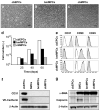Engineering robust and functional vascular networks in vivo with human adult and cord blood-derived progenitor cells
- PMID: 18556575
- PMCID: PMC2746761
- DOI: 10.1161/CIRCRESAHA.108.178590
Engineering robust and functional vascular networks in vivo with human adult and cord blood-derived progenitor cells
Abstract
The success of therapeutic vascularization and tissue engineering will rely on our ability to create vascular networks using human cells that can be obtained readily, can be expanded safely ex vivo, and can produce robust vasculogenic activity in vivo. Here we describe the formation of functional microvascular beds in immunodeficient mice by coimplantation of human endothelial and mesenchymal progenitor cells isolated from blood and bone marrow. Evaluation of implants after 1 week revealed an extensive network of human blood vessels containing erythrocytes, indicating the rapid formation of functional anastomoses within the host vasculature. The implanted endothelial progenitor cells were restricted to the luminal aspect of the vessels; mesenchymal progenitor cells were adjacent to lumens, confirming their role as perivascular cells. Importantly, the engineered vascular networks remained patent at 4 weeks in vivo. This rapid formation of long-lasting microvascular networks by postnatal progenitor cells obtained from noninvasive sources constitutes an important step forward in the development of clinical strategies for tissue vascularization.
Conflict of interest statement
Figures






Comment in
-
Therapeutic vasculogenesis: it takes two.Circ Res. 2008 Jul 18;103(2):128-30. doi: 10.1161/CIRCRESAHA.108.180604. Circ Res. 2008. PMID: 18635829 Free PMC article. No abstract available.
References
-
- Jain RK, Au P, Tam J, Duda DG, Fukumura D. Engineering vascularized tissue. Nat Biotechnol. 2005;23:821–823. - PubMed
-
- Isner JM, Pieczek A, Schainfeld R, Blair R, Haley L, Asahara T, Rosenfield K, Razvi S, Walsh K, Symes JF. Clinical evidence of angiogenesis after arterial gene transfer of phVEGF165 in patient with ischaemic limb. Lancet. 1996;348:370–374. - PubMed
-
- Lee H, Cusick RA, Browne F, Ho Kim T, Ma PX, Utsunomiya H, Langer R, Vacanti JP. Local delivery of basic fibroblast growth factor increases both angiogenesis and engraftment of hepatocytes in tissue-engineered polymer devices. Transplantation. 2002;73:1589–1593. - PubMed
-
- Li X, Tjwa M, Moons L, Fons P, Noel A, Ny A, Zhou JM, Lennartsson J, Li H, Luttun A, Ponten A, Devy L, Bouche A, Oh H, Manderveld A, Blacher S, Communi D, Savi P, Bono F, Dewerchin M, Foidart JM, Autiero M, Herbert JM, Collen D, Heldin CH, Eriksson U, Carmeliet P. Revascularization of ischemic tissues by PDGF-CC via effects on endothelial cells and their progenitors. J Clin Invest. 2005;115:118–127. - PMC - PubMed
Publication types
MeSH terms
Grants and funding
LinkOut - more resources
Full Text Sources
Other Literature Sources

